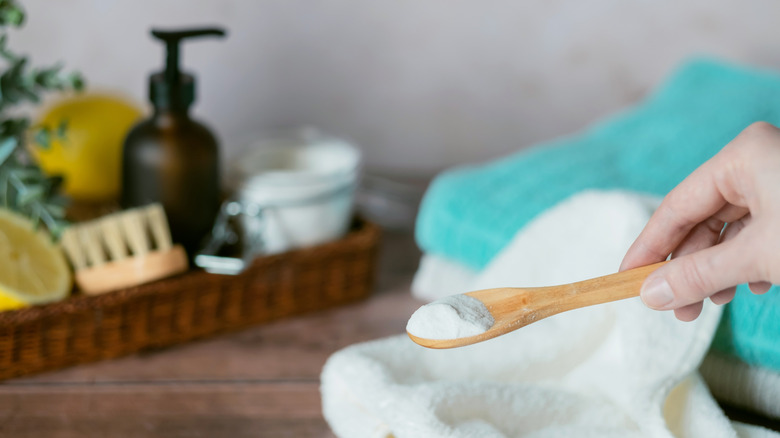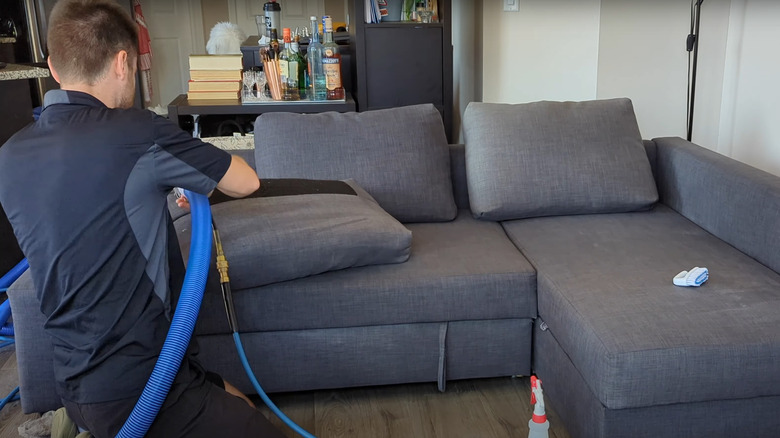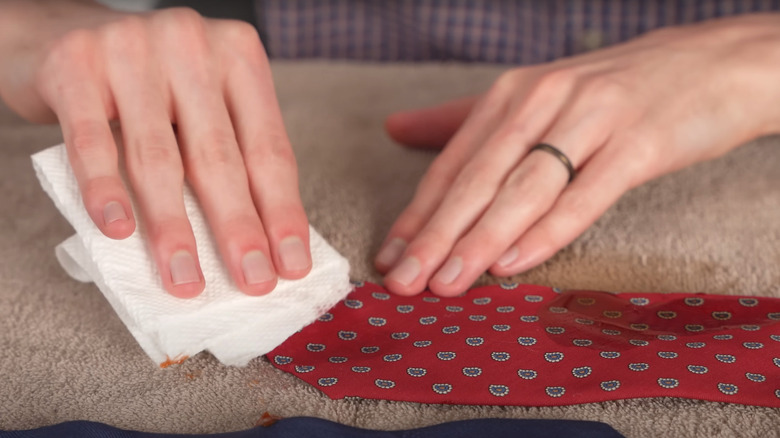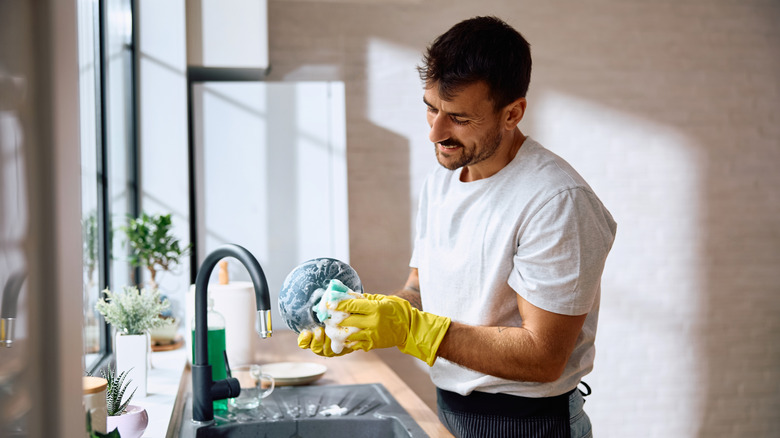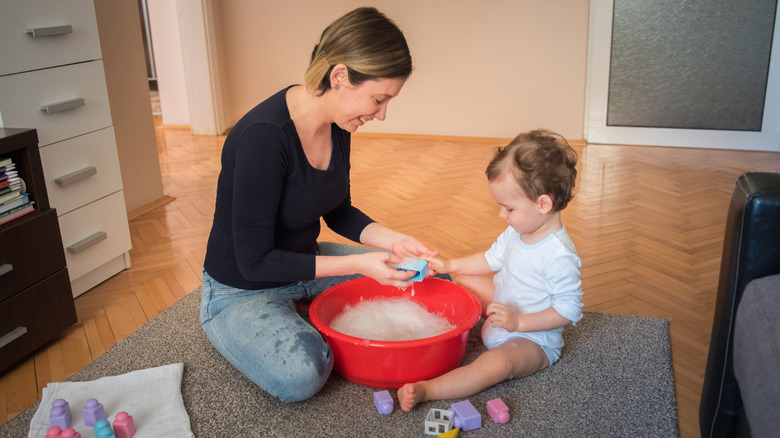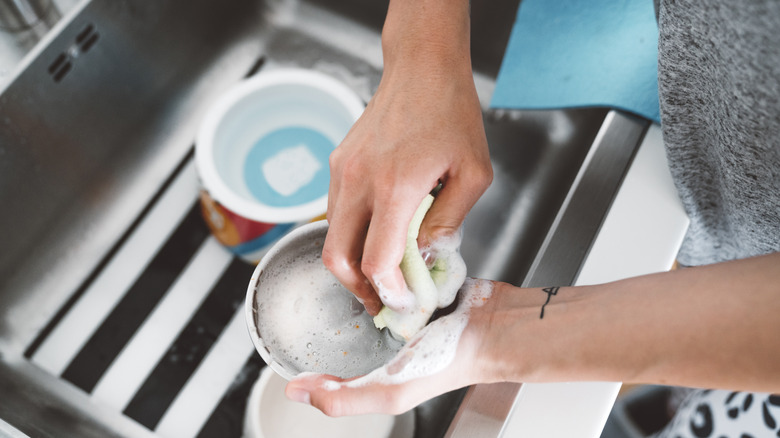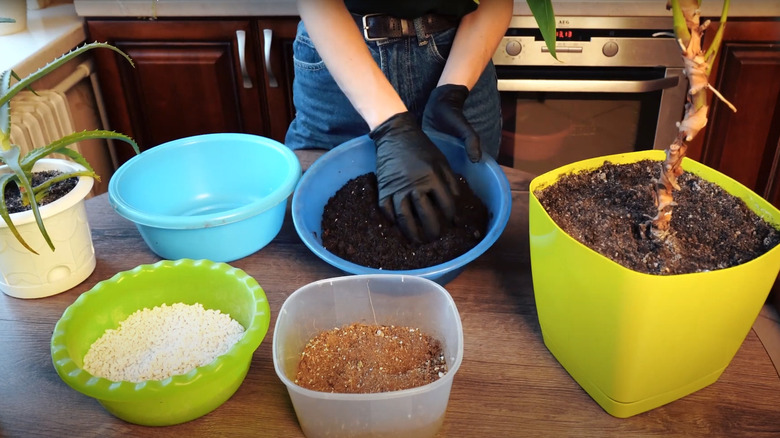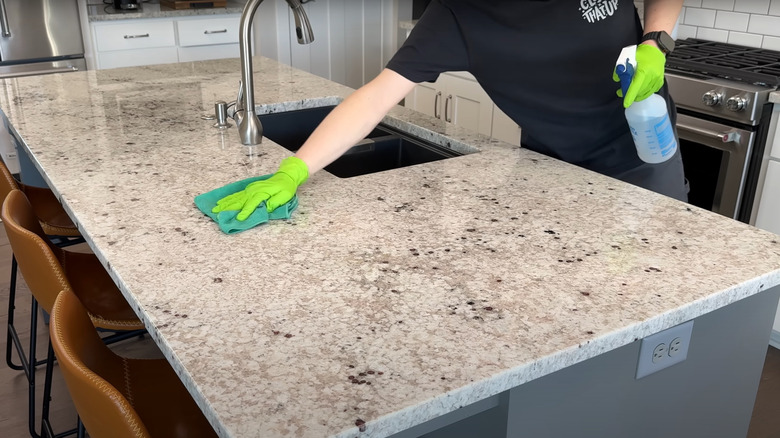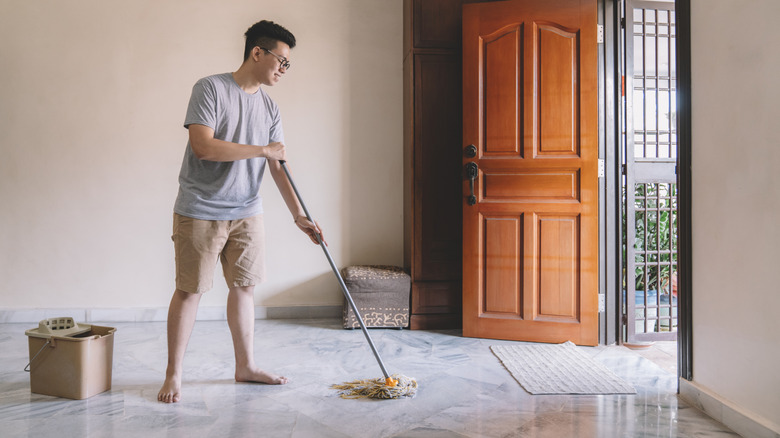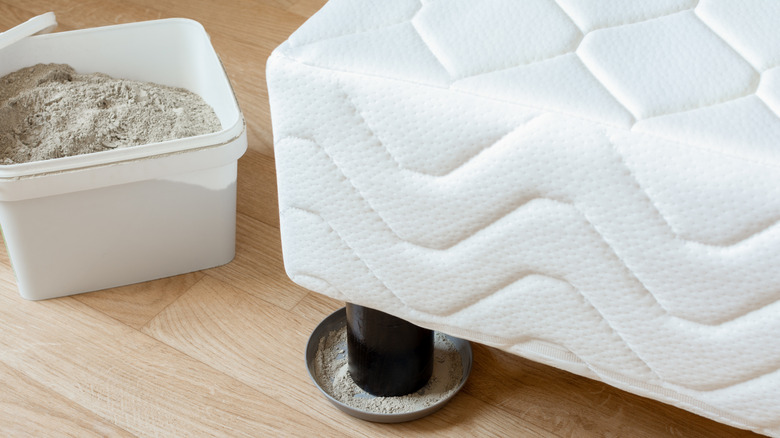9 Things In Your Home You Should Never Clean With Borax
We may receive a commission on purchases made from links.
Borax is the secret weapon behind an immaculately clean home and has been a common household staple since its popularity boom in the late 19th century. The biggest selling point behind it is that it's an "all-natural" product, and its most loved for cleaning uses and some pest control. Known also as sodium borate, sodium tetraborate, or disodium tetraborate, this white powder consists of boron, sodium, and oxygen. Borax powder may be natural, but this doesn't mean it's safe to use throughout your entire home. There are many materials and surfaces where borax can have negative effects. This leads to potential risks concerning your house, furniture, and even household members.
Borax is alkaline with a pH of about 9 to 9.5. The high pH causes certain materials to discolor, fray, or break down. Borax is also toxic if accidentally ingested, making it potentially dangerous to leave around children and pets. Bearing these characteristics in mind, there are some places you should avoid using borax as a DIY cleaning solution. Read on to learn about what should never be cleaned with borax, why you should avoid it, and what alternative cleaning solutions to pursue instead.
Borax dulls the color of azo-dyed curtains, rugs, and upholstered furniture
Borax is often used to brighten upholstery and home decor, however, it can have the opposite effect when used on certain dye jobs. High pH levels degrade azo dyes, which are common synthetic colorings used in various textile industries. Applying borax to azo-dyed curtains, rugs, and other upholstery leads to potential fading and discoloration due to borax's alkalinity. This discoloration isn't reversible and can ruin the colorful decor and furniture adorning your home.
Borax is safe for fabrics resistant to high alkaline levels, such as olefin fabric. Olefin is commonly used in heavy-duty and outdoor furniture, and in most cases, borax brightens and spot-cleans these items. Regarding other interior fabrics, you should be wary when removing stains. Director of Franchise Operations at Two Maids, Kathy Cohoon, told Martha Stewart how to use borax safely on furniture: "Mix together 1 cup of borax with 4 cups of warm water. Apply the mixture to the furniture and allow to sit for up to 30 minutes, then rinse with warm water." However, if you don't want to risk damaging furniture, especially luxurious materials like silk or wool, which are sensitive to alkalinity, take a look at the care tag on your carpet, drapes, and furniture before using any cleanser.
Borax breaks down fabrics commonly used for clothing
One of borax's most common uses is for brightening and spot-cleaning laundry. Being used as often as it is, there are many mistakes everyone makes when using borax in the laundry. It isn't an all-encompassing solution for all fabric types. The high pH level and alkaline properties are known to break down several materials in the textile industry. Borax deteriorates cellulose, a common ingredient in cotton, flax, hemp, jute, and sisal fabrics, though they have some resistance to it when used sparingly. Borax is most damaging when used on protein fibers, such as silk and wool.
When removing stains or brightening clothing items, look at care tags and see what the manufacturers recommend for cleaning. The washing instructions may advise sticking to neutral pH detergents if clothing items are made of silk, wool, or stain-resistant fabrics. A specialized cleaner like Grandma's Secret Spot Remover works on cotton, silk, wool, and more, and is applied in a similar fashion to borax for spot cleaning. Dab a small amount on a stain, let it sit for up to 10 minutes, and wash the fabric as you normally would.
Borax used to wash dishes can leave toxic remnants behind
Borax works well to scour stubborn debris from dishes and the inside of a dishwasher, but other options are a lot less risky. Minuscule amounts of borax are toxic when ingested. Even as little as 5 grams is lethal to small children. If remnants end up on dishes or utensils used for eating, someone in your household could accidentally ingest it with their food. Even if it isn't a lethal dose, there can still be painful consequences. Pharmacist Dr. Shireen Banerji told How Stuff Works that "[If] accidentally swallowed, it could cause gastrointestinal distress, or more (depending on the amount)."
Instead of using borax as an abrasive ingredient for dishwashing chores, take other natural routes to remove sticky food residue or dishwasher buildup. Baking soda has adverse side effects when ingested in large quantities, due to it's high sodium content, but it is also safe to consume up to a certain amount. Conclusively, it has the same scouring power as borax, but with a far lower toxicity risk. Find other simple ways to make cleaning dishes easier by soaking especially tough dishes in warm water or using a powerful dish detergent like Dawn Platinum Dishwashing Liquid.
Borax can leave poisonous remnants on baby and young children's toys
Baby and children's toys tend to get dirty easily. Kids chew on toys, leave them on the floor, drop them outdoors, and handle them after eating, making it easy for dirt, oil, and grime to build up in just a couple of hours. It's tempting to use borax to scrub the toys clean, since this abrasive texture dislodges dirt and makes it easier to remove without damaging the surface underneath. Even though borax is usually safe to use on plastic, a common material in kids' toys, it is harsh on children's skin and stomachs. As mentioned previously, if even 5 grams of borax powder is left on the toy, it could be incredibly harmful if accidentally ingested. Besides, borax isn't a sufficient sanitizer for removing harmful bacteria and germs anyway.
No sanitizer is truly safe for children to digest, but most health departments recommend a diluted chlorine bleach solution using ¼ teaspoon of unscented bleach for every quart of water. The chlorine evaporates as it dries, ensuring there's no leftover residue as there would be with borax. Hot water and dye-free, unscented detergents also make acceptable cleansers for kids' toys.
Borax can poison pets if used for food bowls and toys
Borax is just as dangerous for cleaning animal food bowls as it is for cleaning human dishes. If dogs, cats, and other pets ingest borax, they could have health issues as a result (the lethal dose is about 1 gram of borax per kilogram of body weight). Risks are even higher with younger or older animals. Borate poisoning is a recognized issue in pet communities, and though it's unlikely the pet would ingest lethal amounts via leftover residue from cleaning, they can still encounter gastrointestinal issues, excessive thirst, skin and eye irritation, and more.
Eliminate the risk of accidental poisoning by following official guidelines for sanitizing pet food bowls and toys. The FDA recommends washing pet bowls and scooping utensils with soap and hot water after every use. Veterinarians say that many laundry detergents and antibacterial soaps are safe to wash toys, as long as you avoid products with ingredients like ammonia, chlorine, formaldehyde, isopropyl alcohol, and phenol, all of which can cause a variety of symptoms ranging from respiratory and gastrointestinal issues to skin irritation. If you insist on using bleach, be sure to make diluted household bleach solution that includes ¼ cup of bleach and 1 gallon of water, as recommended by the CDC. Soak the item in the solution for about 10 minutes, and then rinse thoroughly with clean water.
Borax kills mold, but also damages houseplant foliage
Borax is a popular DIY way to remove mold from around your home, but you should be careful in regards to where you apply it. Borax is toxic to more than animals and people — it's also a herbicide. It'll remove mold from moldy houseplants, though it can also kill those plants in the process. The boric acid disrupts cell development and photosynthesis, leading to diminished growth and making it ultimately fatal when used to smother mold and fungus spores. Borax also can destroy plants because it acts as a desiccant and dries them out.
Borax isn't the right choice for getting rid of white mold on plants at home, but there are plenty of other natural options. In many cases, the safest bet is to quarantine infected plants, removing all foliage with signs of mold spores. Clip and trash infected leaves and stems, and replace the soil with a brand-new, mold-free mixture. If necessary, change up your plant care tactics the next go-around. All this being said, borax can be used in small amount in soil to boost boron content (boron deficiencies can cause stunted growth). Don't be afraid to apply borax as a fertilizer by incorporating it into the soil before planting (use about 1 tablespoon per 100 square feet of soil). Or you can mix 1 tablespoon of borax with 1 to 3 gallons of water, and apply about 1 ounce of the solution to the soil around each plant. Keep in mind that this minuscule amount only works as a fertilizer and won't do anything against mold growth.
Borax etches and dulls natural stone countertops
Once of the most important rules for keeping your natural stone countertops looking their best is to clean and maintain them properly. Above all else, avoid cleaning products with extreme pH levels, such as highly alkaline and highly acidic solutions. Alkaline-leaning solutions, like borax, cause etching in surfaces. Etching refers to when countertops granite, marble, and other popular stone countertop materials get dulled and discolored. This is an even bigger risk for countertops with glossy and polished finishes.
Since the general consensus is that borax is not safe to use on stone countertops, take an alternative route with a pH-neutral cleaner and polisher. If a cleaner doesn't have the pH listed or advertises being alkaline or acidic, play it safe and choose another option. Start by checking out the best stone home solutions for cleaning granite countertops, where you can find products like Weiman Disinfectant Granite & Stone Clean & Shine. Although this product has granite in the name, the brand ensures it also works on non-porous sealed marble, limestone, slate, and tile surfaces.
Borax breaks down natural stone flooring
Borax is a powerful ingredient that works like magic to clean walls, but you should think twice before using it to scrub natural stone floors. It has the same effect as when used on stone countertops — the alkaline pH discolors and scuffs limestone, marble, terrazzo, travertine, and other luxurious flooring types. Borax and other alkaline cleaners (in addition to highly acidic cleaners) damage and disfigure these surfaces by dulling the sealant layers and etching over time. Using borax continuously causes etching to get worse. At first it may only be visible in the reflection of the stone surface, however, it can eventually cause portions of flooring to feel rough and uneven.
Most floors don't need a deep clean every day. COO of The Cleaning Authority, Leanne Staph, told Martha Stewart, "It is best to clean your floors every one to two weeks. Be sure to regularly sweep your floors, especially when cooking a lot, to make sure food and other debris does not get kicked around and scratch up the floors." Aside from the routine sweep, don't use anything too extreme to clean and polish. Use a commercial cleaner specifically designed for the stone type you have. Ensure you follow the manufacturer's directions, either from the stone slab supplier or the cleaning formula itself, to ensure the safety of expensive stone flooring.
Borax is dangerous for treating pest infestations in pet-occupied rooms
Borax is a potential pest control solution, but plenty of other natural methods are more effective while simultaneously being safer for pets. Borax dehydrates bugs in a similar fashion to diatomaceous earth. It also affects the pests' digestive and nervous systems. One of the main differences is that borax is not available in a food-grade form. If you sprinkle borax around furniture and room corners occupied by animals, they could potentially sniff out the powder, accidentally inhaling or ingesting it. As mentioned previously, just a few grams of borax powder can have severe health effects, making it an unadvisable pest solution.
If you're lucky, your pets might avoid the powder altogether. In fact, the MSD Veterinary Manual claims that borax poisoning isn't common when borax is applied correctly, but it occurs when it is accidentally scattered among animal feed or is left for pets to freely access. It's safer to use this ingredient in rooms without any animals, pet food, or pet toys. If your animals frequent the room that needs pest treatment, the safest bet is to start with other natural methods that have less risk. Try sprinkling Harris Food Grade Diatomaceous Earth Powder around your home instead. It is safe for pets when used correctly and in controlled amounts.
